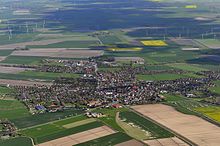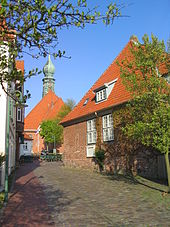Wesselburen
| coat of arms | Germany map | |
|---|---|---|

|
Coordinates: 54 ° 13 ' N , 8 ° 55' E |
|
| Basic data | ||
| State : | Schleswig-Holstein | |
| Circle : | Dithmarschen | |
| Office : | Büsum-Wesselburen | |
| Height : | 2 m above sea level NHN | |
| Area : | 5.14 km 2 | |
| Residents: | 3415 (Dec. 31, 2019) | |
| Population density : | 664 inhabitants per km 2 | |
| Postcodes : | 25762-25764 | |
| Area code : | 04833 | |
| License plate : | HEI, MED | |
| Community key : | 01 0 51 127 | |
| LOCODE : | DE 68F | |
| Office administration address: | Kaiser Wilhelm-Platz 25761 Büsum |
|
| Website : | ||
| Mayor : | Heinz-Werner Bruhs ( CDU ) | |
| Location of the city of Wesselburen in the Dithmarschen district | ||
Wesselburen is a town in the Dithmarschen district in Schleswig-Holstein .
history
Wesselburen was built on two Wurten in the marshland that were already inhabited over 1000 years ago, and over time it has grown into a larger settlement. According to archaeological findings, the central Dorfwurt dates from the 8th to 9th centuries and has been continuously increased. By the 12th century at the latest, the place, first mentioned in documents in 1281, had the structure it is today: starting from the highest point on which the church is located, the main streets radiate out from the historic town center.
Markets have been held in the village since 1625 . In 1736 almost the entire village burned down and then had to be almost completely rebuilt.
Julius Groth founded a local newspaper in Wesselburen in 1865 , the Dithmarscher Bote . In 1868 the district court was created, which had to close in 1970.
The sugar ( beet ) factory, which was in operation from 1869 to 1908, is a specialty . The Itzeho merchant Charles de Vos had found through tests that the beets in the Nordermarsch had a particularly high sugar content. Due to the lower sugar prices and the relatively remote location of the place, the factory had to cease operations.
Wesselburen was connected to the public railway network in 1878: the Heide- Wesselburen railway line was created, which was expanded to the seaside resort of Büsum in 1883 . In 1893 the first power station was built .
On October 16, 1899, the place received city rights and thus retired from the parish of the same name . In 1915, sauerkraut production was started in the old sugar factory (from 1948 by the Philipp company), which finally came to an end in 1995. Despite the black numbers in Wesselburen, production was relocated to the New Federal States .
In the Reichstag election in March 1933 in the parish of Wesselburen, 78.8% voted for the NSDAP , 6.9% for the DNVP , 6.5% for the SPD and 6.8% for the KPD, with a turnout of 88.5%.
In 1964, Wesselburen hit the headlines nationwide and later even internationally: despite criticism of the anti-Semite Adolf Bartels, the city held on as the namesake of a street and as an honorary citizen . It was not until April 1966 that Adolf-Bartels-Strasse was renamed Wulf-Isebrand-Strasse . Honorary citizenship was only revoked in 1986.
On May 25, 2008, the city gave up its freedom of office and formed the office Büsum-Wesselburen with the municipalities of the offices of Parish Landgemeinde Büsum and Kirchspielslandgemeinde Wesselburen (excluding Norderwöhrden ) . With this, Wesselburen also lost the office of full-time mayor at the end of April 30, 2010.
politics
City Council
Of the 17 seats in the city council, the CDU has six seats since the local elections in 2018, and the SPD also has six. The WGW voting community has three and the FDP two seats.
coat of arms
Blazon : “In red a silver half-timbered house with horse heads on the gable and a closed gate on a green hill, which is covered with a silver strip; from it three silver stakes extend in a fan shape to the lower edge of the shield. "
Town twinning
In 1963 the city sponsored the city of Daber in Pomerania in the sense of a sponsorship for the residents who had been expelled from Daber.
mayor
|
|
Economy and Infrastructure
Wesselburen used to be mainly characterized by agricultural production. In addition to wheat , rye and oats , cabbage , beets and potatoes were mainly grown. Today Wesselburen is above all a tourist destination.
traffic
The place is on the Büsum – Heide – Neumünster railway line and at the intersection of several state roads.
Educational institutions
- Elementary School Wesselburen
- Eider-Nordsee-Schule (community school)
- Friedrich Elvers School (special needs school)
- Adult Education Center Wesselburen e. V.
- House of Youth - Wesselburen
Attractions
In the list of cultural monuments in Wesselburen are the cultural monuments entered in the list of monuments of Schleswig-Holstein.
The Hebbel Museum is located in the residence and office of the former parish bailiff, where Hebbel worked in his unhappy youth in Wesselburen. Part of the historic interior has been preserved. The building houses a collection on Hebbel and, in particular, an extensive research library on the poet.
The Kohlosseum is a special cabbage- themed museum that opened in 2008.
The Eider Barrage is located in the municipality of Tönning in North Frisia, but is right next to the town's bathing beach.
A special feature is the formerly so-called "Katzenschloss", the "Villa Assmus". The castle-like house with three corner towers was built in 1903 by the Wesselburen banker Julius Assmus after he had sold the private bank C. J. Assmus founded by his father. The building has a total of ten rooms and four bathrooms on 600 square meters. Assmus himself died in 1905 on the wedding night of his second marriage. In the following decades it served as a private home for Assmus' widow, the cabbage dealer Johannes Bielenberg, the grain dealer Wilhelm Witt and later his widow. After 1945 it served temporarily as refugee accommodation before it came back into private hands. From 1988 to 1997, a family originally from Hamburg ran a luxury cat hostel in the house, which is why the building got its slang name. It has been privately owned again since 2000, the current owner from Henstedt-Ulzburg is having it extensively renovated with the intention of finding its retirement home there later.
The dominant building in the Wesselburen cityscape is the Church of St. Bartholomew . It is located at the highest point of the village on a Wurt, its characteristic onion dome can still be seen from many kilometers away.
Originally probably built in the 12th century, the church burned down in 1736, only the Romanesque - Gothic outer walls remained. The builder Johann Georg Schott completely redesigned it in 1737/1738. It is a unique Baroque church in the region . Schott integrated the previously isolated round tower and the choir under a large roof reminiscent of a hooded coffin . In its center is a relatively large roof turret with an onion tip modeled on Russian churches.
Sports
- Boßelverein "Attention Wesselburen"
- Citizens Guild Wesselburen
- Shooting club "Gut Schuss" Wesselburen / Land
- Sailing Association Eiderdamm e. V.
- Sport fishing club
- Squash club Wesselburen nice-im-Let
- SV Blau-Weiß Wesselburen e. V.
Regular events
- The Elm Festival has been taking place on the market square in July since 1984; it is named after an elm that was there before.
- The Dithmarscher Cabbage Days in September are also of great importance in the city in which the Dithmarscher cabbage cultivation was established and lead, among other things, to a market in the city center.
- For some years now, the Wesselburen summer evenings with stalls and an entertainment program have been taking place at the market on some Wednesday evenings in July and August.
Personalities
sons and daughters of the town
- Adolf Bartels (1862–1945), anti-Semitic poet and literary historian
- Nicolaus Boie the Elder (? –1542), German reformer.
- Kirsten Fehrs (* 1961), bishop
- Erwin Freytag (1907–1987), author and Evangelical Lutheran theologian
- Friedrich Hebbel (1813–1863), poet and playwright
- Friedrich Christian Heylmann (1771–1836 / 1837), master builder
- Karl Herwig (1895–1967), NSDAP mayor of the cities of Wesselburen and Heide (Holstein), SS Oberführer and war criminal
- Jürgen Koppelin (* 1945), NDR presenter, honorary chairman of the FDP Schleswig-Holstein
- Sabine Kunst (* 1954), President of the Humboldt University in Berlin, former Minister of Science of the State of Brandenburg, former President of the University of Potsdam
- Michael Matz (* 1959), General in the Bundeswehr
- Christian Otto Mohr (1835–1918), civil engineer
- Max Pauly (1907–1946), concentration camp commandant and war criminal
- Ottilie Reylaender (1882–1965), painter
- Jil Sander (* 1943), fashion designer
- Johannes B. Vorst (1623–1676), philologist and theologian
Associated with Wesselburen
- Thomas Selle (* 1599 in Zörbig ; † 1663 in Hamburg ), composer, worked between 1625 and 1634 as rector and head of church music in Wesselburen.
- Christian Heuck (* 1892 in Heuwisch , Dithmarschen , † 1934 in Neumünster ), member of the Reichstag of the KPD and resistance fighter against the Nazis.
- Torge Oelrich (* 1988 in Heide ), German comedian, actor and web video producer.
literature
- Nis R. Nissen : State and Church in Dithmarschen. West Holstein Publishing House Boyens & Co., Heide 1994
Web links
Individual evidence
- ↑ North Statistics Office - Population of the municipalities in Schleswig-Holstein 4th quarter 2019 (XLSX file) (update based on the 2011 census) ( help on this ).
- ↑ State Statistical Office Schleswig-Holstein (ed.): The population of the communities in Schleswig-Holstein 1867 - 1970 . State Statistical Office Schleswig-Holstein, Kiel 1972, p. 55 .
- ↑ AKENS Information 39, Omland: "All of us 'yes' to the leader". Retrieved November 26, 2019 .
- ↑ Martin Gietzelt: “The overpainted consciousness. 'Brown' teaching staff in Büsum and brazen high school graduates ”. ( Memento of the original from February 27, 2009 in the Internet Archive ) Info: The archive link was automatically inserted and not yet checked. Please check the original and archive link according to the instructions and then remove this notice.
- ↑ Martin Gietzelt: Laborious coming to terms with the past ( page no longer available , search in web archives ) Info: The link was automatically marked as defective. Please check the link according to the instructions and then remove this notice. ; in Dithmarscher Landeszeitung on May 30, 2007
- ↑ http://www.wesselburen-online.de/politik/stadtvertretung/index.html
- ↑ Schleswig-Holstein's municipal coat of arms
- ^ Reprint of the sponsorship certificate in: Die Pommersche Zeitung. No. 12/2009, p. 5.
- ↑ Ralf Tiessen: “Living like a fairy tale - Gerd Goerke from Henstedt-Ulzburg is realizing his dream in Wesselburen.” Dithmarscher Landeszeitung, May 2, 2007 p. 20
- ↑ Edward Schröder: Vorst, Johannes . In: Allgemeine Deutsche Biographie (ADB). Volume 40, Duncker & Humblot, Leipzig 1896, p. 308 f.







